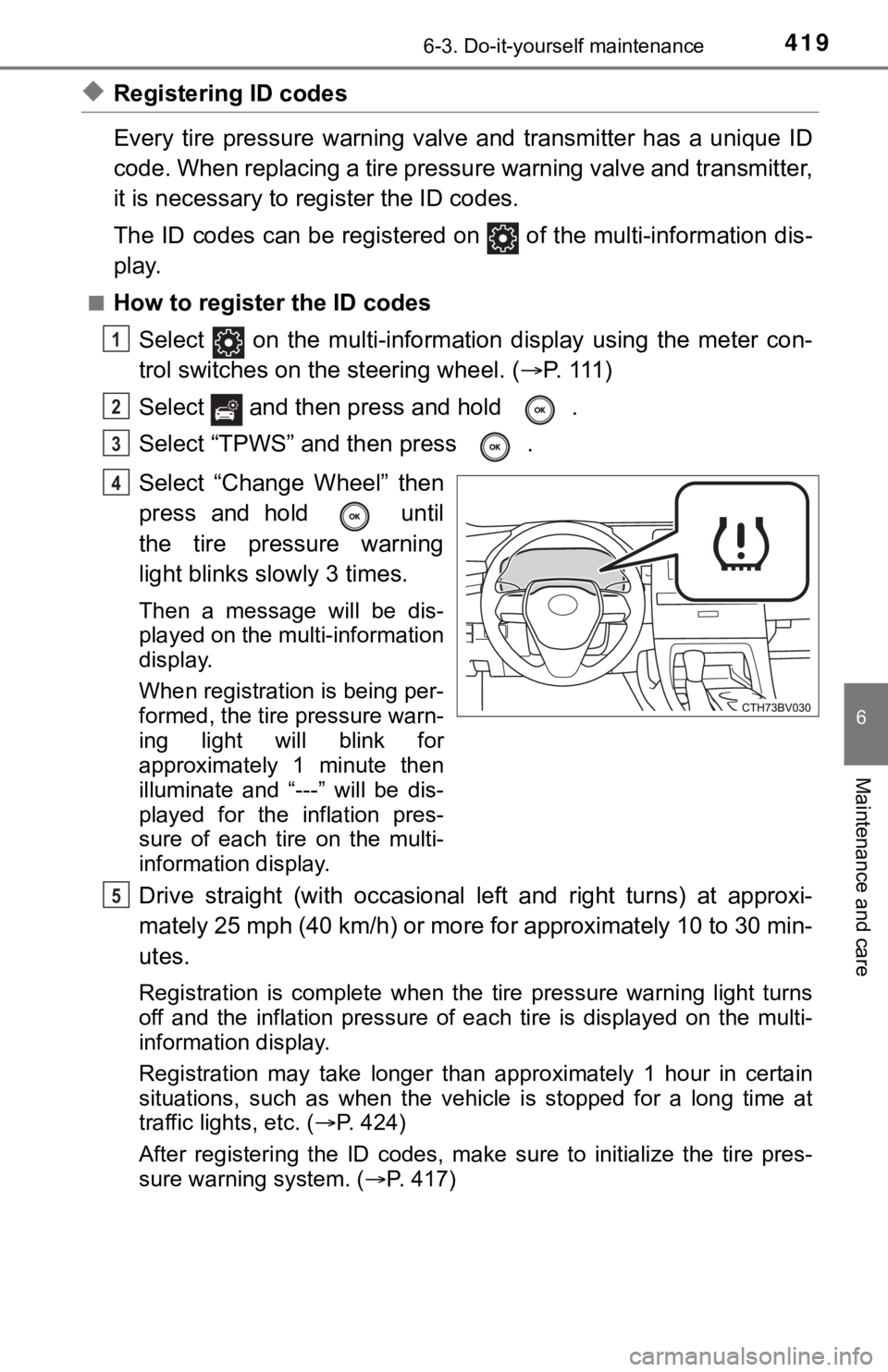Page 385 of 560

385
6Maintenance and care
6-1. Maintenance and care
Cleaning and protecting
the vehicle exterior .......... 386
Cleaning and protecting
the vehicle interior ........... 389
6-2. Maintenance
Maintenance
requirements ................... 392
General maintenance........ 394
Emission inspection and
maintenance (I/M)
programs......................... 398
6-3. Do-it-yourself
maintenance
Do-it-yourself service
precautions ..................... 399
Hood ................................. 401
Positioning a floor jack ...... 402
Engine compartment ......... 403
12-volt battery ................... 411
Tires .................................. 415
Tire inflation pressure ....... 427
Wheels .............................. 430
Air conditioning filter.......... 432
Cleaning the hybrid
battery (traction battery)
air intake vent and
filter ................................. 434
Electronic key battery........ 439
Checking and replacing
fuses ............................... 442
Light bulbs......................... 445
Page 396 of 560

3966-2. Maintenance
Seat belts
• Do the seat belts operate
smoothly?
• The seat belts should not be dam-
aged.
Seats• Do the seat controls operate prop-
erly?
Steering wheel
• Does the steering wheel rotate
smoothly?
• Does the steering wheel have the
correct amount of free play?
• There should not be any strange
sounds coming from the steering
wheel.
Vehicle exterior
ItemsCheck points
ItemsCheck points
Doors/trunk• Do the doors/trunk operate
smoothly?
Engine hood• Does the engine hood lock system
work properly?
Fluid leaks
• There should not be any signs of
fluid leakage after the vehicle has
been parked.
Tires
• Is the tire inflation pressure cor-
rect?
• The tires should not be dam-
aged or excessively worn.
• Have the tires been rotated
according to the maintenance
schedule?
• The wheel nuts should not be
loose.
Windshield wipers
• The wiper blades should not show
any signs of cracking, splitting,
wear, contamination or deforma-
tion.
• The wiper blades should clear the
windshield without streaking or
skipping.
Page 400 of 560

4006-3. Do-it-yourself maintenance
Tire inflation
pressure
(P. 427)• Tire pressure gauge
• Compressed air source
Washer fluid
(P. 410)• Water or washer fluid containing antifreeze (for win-
ter use)
• Funnel (used only for adding water or washer fluid)
WARNING
The engine compartment contains many mechanisms and fluids that may
move suddenly, become hot, or become electrically energized. To avoid death
or serious injury, observe the following precautions.
■When working on the engine compartment
●Make sure that the “ACCESSORY” or “IGNITION ON” on the multi-infor-
mation display and the “READY” indicator are both off.
●Keep hands, clothing and tools away from the moving fan and engine
drive belt.
●Be careful not to touch the engine, power control unit, radiator, exhaust
manifold, etc. right after driving as they may be hot. Oil and other fluids
may also be hot.
●Do not leave anything that may burn easily, such as paper and rags, in the
engine compartment.
●Do not smoke, cause sparks or expose an open flame to fuel. Fuel fumes
are flammable.
■When working near the electric cooling fan or radiator grille
Be sure the power switch is off.
With the power switch in ON mode, the electric cooling fan may automati-
cally start to run if the air conditioning is on and/or the coolant temperature
is high. (P. 408)
■Safety glasses
Wear safety glasses to prevent flying or falling material, fluid spray, etc.
from getting in your eyes.
NOTICE
■If you remove the air cleaner filter
Driving with the air cleaner filter removed may cause excessive engine wear
due to dirt in the air.
ItemsParts and tools
Page 416 of 560
4166-3. Do-it-yourself maintenance
Your vehicle is equipped with a tire pressure warning system that uses
tire pressure warning valve and transmitters to detect low tire inflation
pressure before serious problems arise.
●The tire pressure detected by
the tire pressure warning sys-
tem can be displayed on the
multi-information display.
●If the tire pressure drops below
a predetermined level, the
driver is warned by a screen
display and a warning light.
(
P. 458)
Tire pressure warning system
Page 417 of 560

4176-3. Do-it-yourself maintenance
6
Maintenance and care
◆Installing tire pressure warning valves and transmitters
When replacing the tires or wheels, the tire pressure warning valve
and transmitters must be installed to the wheels which will be
installed to the vehicle.
When new tire pressure warning valve and transmitters are
installed, new ID codes must be registered in the tire pressure
warning computer and the tire pressure warning system must be
initialized. (P. 419)
◆Initializing the tire pressure warning system
■The tire pressure warning system must be initialized in the fol-
lowing circumstances:
●When the tire inflation pressure is changed such as when chang-
ing traveling speed or load weight.
●When the tire inflation pressure is changed such as when the tire
size is changed.
●When rotating the tires.
●After performing the transmitter ID code registration procedure.
(P. 419)
When the tire pressure warning system is initialized, the current tire
inflation pressure is set as the benchmark pressure.
■How to initialize the tire pressure warning system
Park the vehicle in a safe place and turn the power switch off.
The initialization procedure cannot be started while the vehicle is
moving.
Adjust the tire inflation pressure to the specified cold tire inflation
pressure level. (P. 508)
Make sure to adjust the tire pressure to the specified cold tire infla-
tion pressure level. The tire pressure warning system will operate
based on this pressure level.
Start the hybrid system. (P. 1 9 6 )
Select on the multi-information display using the meter con-
trol switches on the steering wheel. (P. 1 1 1 )
Select and then press and hold .
Select “TPWS” and then press .
1
2
3
4
5
6
Page 418 of 560
4186-3. Do-it-yourself maintenance
Select “Set Pressure” then
press and hold until
the tire pressure warning
light blinks 3 times.
Then a message will be dis-
played on the multi-information
display.
“---” will be displayed on the
multi-information display for
the inflation pressure of each
tire while initialization is being
performed.
Drive straight (with occasional left and right turns) at approxi-
mately 25 mph (40 km/h) or more for approximately 10 to 30 min-
utes.
Initialization is complete when the position of each tire is determined
and the inflation pressure of each tire is displayed on the multi-infor-
mation display.
Initialization may take longer than approximately 1 hour in certain
situations, such as when the vehicle is stopped for a long time at
traffic lights, etc. (P. 423)
7
8
Page 419 of 560

4196-3. Do-it-yourself maintenance
6
Maintenance and care
◆Registering ID codes
Every tire pressure warning valve and transmitter has a unique ID
code. When replacing a tire pressure warning valve and transmitter,
it is necessary to register the ID codes.
The ID codes can be registered on of the multi-information dis-
play.
■How to register the ID codes
Select on the multi-information display using the meter con-
trol switches on the steering wheel. (P. 1 1 1 )
Select and then press and hold .
Select “TPWS” and then press .
Select “Change Wheel” then
press and hold until
the tire pressure warning
light blinks slowly 3 times.
Then a message will be dis-
played on the multi-information
display.
When registration is being per-
formed, the tire pressure warn-
ing light will blink for
approximately 1 minute then
illuminate and “---” will be dis-
played for the inflation pres-
sure of each tire on the multi-
information display.
Drive straight (with occasional left and right turns) at approxi-
mately 25 mph (40 km/h) or more for approximately 10 to 30 min-
utes.
Registration is complete when the tire pressure warning light turns
off and the inflation pressure of each tire is displayed on the multi-
information display.
Registration may take longer than approximately 1 hour in certain
situations, such as when the vehicle is stopped for a long time at
traffic lights, etc. (P. 424)
After registering the ID codes, make sure to initialize the tire pres-
sure warning system. (P. 417)
1
2
3
4
5
Page 420 of 560

4206-3. Do-it-yourself maintenance
■When to replace your vehicle’s tires
Tires should be replaced if:
●The treadwear indicators are showing on a tire.
●You have tire damage such as cuts, splits, cracks deep enough to
expose the fabric, and bulges indicating internal damage
●A tire goes flat repeatedly or cannot be properly repaired due to the size
or location of a cut or other damage
If you are not sure, consult with your Toyota dealer.
■Replacing tires and wheels
If the ID codes of the tire pressure warning valve and transmitters are not
registered, the tire pressure warning system will not work properly. In this
case, after driving for about 20 minutes, the tire pressure warning light will
blink for approximately 1 minute and then illuminate to indicate a system
malfunction.
■Tire life
Any tire over 6 years old must be checked by a qualified technician even
if it has seldom or never been used or damage is not obvious.
■Routine tire inflation pressure checks
The tire pressure warning system does not replace routine tire inflation
pressure checks. Make sure to check tire inflation pressure as part of
your routine of daily vehicle checks.
■Low profile tires (vehicles with 18 or 19-inch wheels)
Generally, low profile tires will wear more rapidly and tire grip perfor-
mance will be reduced on snowy and/or icy roads when compared to
standard tires. Be sure to use snow tires on snowy and/or icy roads and
drive carefully at a speed appropriate for road and weather conditions.
■Maximum load of tire
Check that the maximum load of the replacement tire is greater than 1/2
of the Gross Axle Weight Ratings (GAWR) of either the front axle or the
rear axle, whichever is greater.
For the GAWR, see the Certification
Label. For the maximum load of the tire,
see the load limit at maximum cold tire
inflation pressure mentioned on the
sidewall of the tire. (P. 5 1 3 )